Symphonic music heard over radio or the loud speakers of sound-picture systems, although very satisfactory, fails to produce in several respects the effect received by one listening to the original production in an auditorium. A full symphony orchestra utilizes air vibrations at nearly all the frequencies the ear can hear, and it uses volumes of sound from about the lowest that can be heard in an ordinary auditorium to volumes one hundred million times greater. The frequency range of such an orchestra, in other words, runs from the neighborhood of 40 cycles per second to perhaps 14,000 cycles, and the volume range extends from about 30 db above the threshold of hearing to 110 db, a total range of 80 db. In contrast with these ranges, radio and sound-picture systems usually have frequency ranges only, 5000 to 8000 cycles, and volume ranges from 35 to 50 db. Moreover a listener in an auditorium receives an added effect from the distribution of the sound in space, a recognition of different sounds coming from different sources.
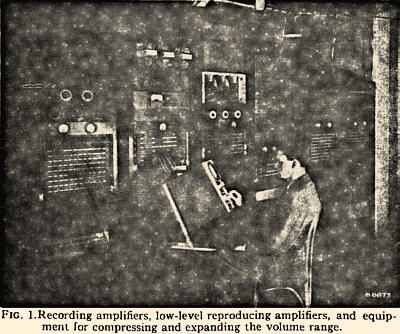
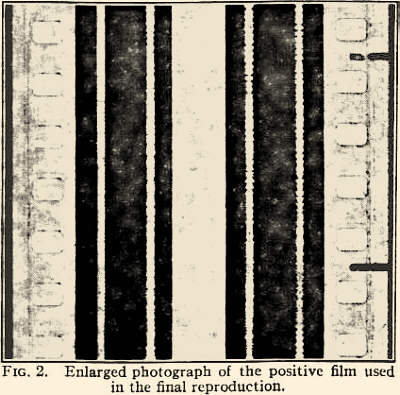
These limitations have long been recognized by the Laboratories, and some years ago an improved sound reproducing system was developed. The result of this work was the stereophonic system demonstrated in Washington and Philadelphia in 1933. Besides reproducing practically the complete frequency range of the orchestra and an enhanced volume range, this system went further in interposing frequency and volume control between the pick-up microphones and the loud speakers to permit the conductor to secure effects unobtainable from the orchestra alone. The music was picked up by three microphones spaced across the front of the stage, and the output from each microphone was carried through its own channel and control equipment to one of three loud speakers spaced across the stage of the auditorium where the reproduction took place.
In the demonstration seven years ago, the music was reproduced at the same time at which it was being played but at a distance from the orchestra. On April 9th of this year a new stereophonic system was demonstrated in New York City, into which another set of steps has been introduced. The music is recorded on film, and is then available for reproduction from the film at any time. Four soundtracks are placed on a single film; one is used for each of the three program channels, and the fourth serves for a control signal. A section of the film is shown in Fig. 2.
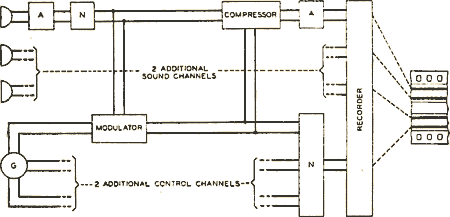
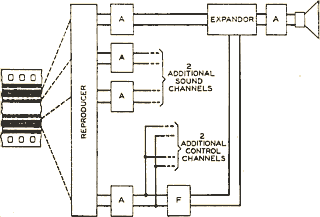
This recording on film might seem a simple thing to do. With music and sound so universally recorded on film for sound pictures, there would seem little difficulty to those not technically familiar with sound-picture systems in recording and reproducing a three-channel stereophonic program. The facts are, however, that ordinary recording and reproduction places no such demands on the equipment as does the stereophonic system. Sound-picture systems transmit a frequency range of less than 8000 cycles, while the stereophonic system employs a band nearly twice as wide. The entire recording and reproducing system had to be designed for this greater range. In addition much greater precautions had to be taken to reduce noise and distortion. An extremely quiet system is required so that music at very low volumes, much lower than used in sound-picture systems, is not marred by the noise, and this is made more difficult because of the wider frequency range, which gives a wider band for the entrance of noise. In addition, there is the matter of increased volume range. The maximum volume range that can be placed on a film is less than 50 db, while the stereophonic system, with the 10-db increase and decrease provided by the enhancement control, requires a range of 100 db. At the very outset, therefore, the recording of music for stereophonic reproduction seems faced with an insuperable obstacle.
The seemingly impossible task of recording a program having a volume range of 100 db on a film that will receive only a 50-db range was accomplished by use of compression and expansion devices performing functions similar to those used on certain transoceanic radio channels. The music as it is picked up by the microphones is passed through a compressor, one being provided for each channel. These allow the music currents to pass to the recording equipment in their normal volume range if below about 45 db; higher volumes are reduced by the compressor so that the limit of the film recording is not overstepped. At the same time a record is made oil another track on the film of just the time and extent of these reductions. At the reproducing end the music currents generated in photoelectric cells from a light-beam passing through the film are carried through an expander before reaching the loud speaker, The action of the expander is controlled by a signal obtained from the additional light track. At any point where the original program was reduced in volume by the compressor, this signal will cause the expander to increase the volume by just the right amount. In this way the full 100-db range in volume is reproduced by the loud speakers without exceeding the 50-db range that is available on the film.
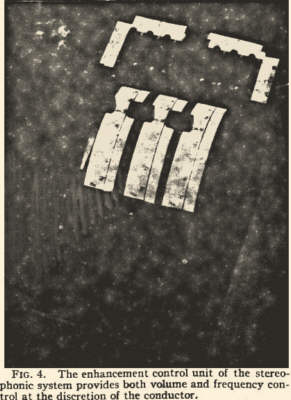
The main elements of the system are indicated on the block diagram shown as Fig. 3. To control the compressor at the recording end, a small amount of the program current is taken from the circuit just ahead of the compressor and is rectified. This rectified current modulates a single-frequency current, which then controls the compressor and also forms the signal placed on the fourth track on the film. Since there are three channels and the amount and time of compression will vary from one to another, three control signals must be recorded on the film, one for each of the three channels. These are all recorded on the same track on the film by allowing the three rectified currents to vary independently the strength of three alternating currents of different frequencies. These modulated currents control their respective compressors and are then combined and recorded as the fourth track.
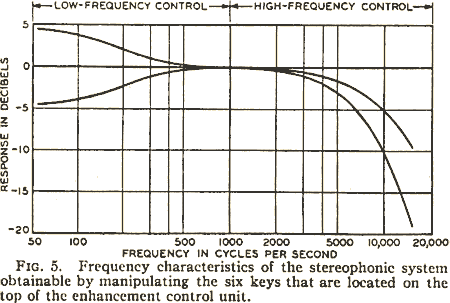
After the film has been made, if the music is then to be enhanced, it is reproduced while the original conductor listens and manipulates the enhancement controls to modify the frequency and volume ranges of the three channels and thus to secure an effect that more nearly suits his interpretation. The enhancement control unit is shown in Fig. 4. At the top are six keys used to control the frequency composition-there is one for each channel for adjusting the high frequencies, and one for each channel for the low frequencies. Each key has three positions and gives the control indicated by Fig. 5. The three handles on the front of the control unit are for adjusting the volumes of the three channels. As the handles are moved up from the normal position, the volume is increased, and as they are moved down, the volume is decreased. As the conductor listens to the reproduction of the original recording, he manipulates these controls, and another film record is made of the enhanced program.
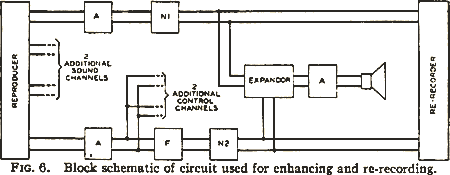
A block schematic for this phase of the operation is shown in Fig. 6, which shows only one channel, however. The changes in frequency characteristics brought about by the enhancement control are secured by the insertion or removal of electrical filters, marked N1 in Fig. 6, in the circuit for each channel. The volume control modifies the current of the auxiliary channel, which is used to control the action of the expanders. Both networks, N1 and N2, are inserted in the circuit ahead of the point where the monitoring circuit is taken off, and thus modify the program as heard by the conductor as well as the currents used for making the new film. On the new film, the three program sound-tracks are the same as on the original film except for the frequency modifications brought about by the filters. The control track, however, has been modified by the manipulation of the enhancement control so as to cause greater or less expansion when result of this process thus represents the enhanced program, and is the one used.
Besides the compressors, expanders, and filters required for this new system there has been a considerable amount of incidental development of the associated parts. There had to be provided, for example, a carefully designed source for the three signal frequencies used to control the expanders, and narrow band-pass filters to separate the three frequencies at the reproducer so that each would control its own expander. Other developments were required to secure accurate timing. The signals must cause the expanders to act at exactly the same point on the film that the compressors had acted during the original recording. In addition, practically every piece of equipment had to be studied and partly re-designed to reduce noise and distortion that in other circumstances would be unobjectionable.

